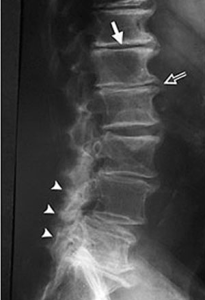
 The premise of my article this month comes form a conversation I had with one of my patients a few months ago. They were looking at the charts on my wall that show muscle trigger points. We use these as an educational tool for patients to help explain anatomy and referred pain.
The premise of my article this month comes form a conversation I had with one of my patients a few months ago. They were looking at the charts on my wall that show muscle trigger points. We use these as an educational tool for patients to help explain anatomy and referred pain.
My patient said that they see another manual therapist who has pictures of arthritic “decaying spines” on their wall and that maybe I should get some too. They see this other therapist every month to get their low back adjustment so as prevent their back from looking like those images. They had no real problems with their low back but assumed that the treatment “must be doing something”.
These type of scare tactics and misinformation really upset me. It made me wonder how many people go along for their weekly or monthly adjustment because they are scared into thinking they should, not because they feel any better for it. Instead they are frightened that if they don’t sign up for a long course of corrective care their spine will crumble and disintegrate into nothing by the time they are sixty.
The fact is there is no evidence whatsoever that your spine will crumble by the time you are sixty just because you haven’t had manual therapy. Sorry to be the bearer of bad news! No amount of cracking, poking, prodding, needling or massaging is going to change that. What we do with our bodies on a daily basis is really far more important. Furthermore, research actually shows that there is a poor correlation between findings of osteoarthritis on X-ray and the amount of pain someone has.
Most of the time the exact cause of osteoarthritis is unknown. Risk factors include being older, a family history of osteoarthritis, being overweight, injury to the joint, bone or joint disorders present at birth and repetitive stressful joint use (such as athletes might experience or from occupational overuse).
Manual therapy can play a supportive role in helping managing osteoarthritis but it cannot reverse it. By improving joint stiffness and muscle tightness it allows patients to live a more active and comfortable life. This in turn complements other important lifestyle factors such as exercise and weight loss which help with prevention and management.
So whilst you can’t control all aspects associated with osteoarthritis if you are generally more active and healthy you will have a much better quality of life.
We hope you come to see us here at Highlands Osteopathy because we help you manage your symptoms and enhance your quality of life rather than because you have been scared into it!
Saskia

